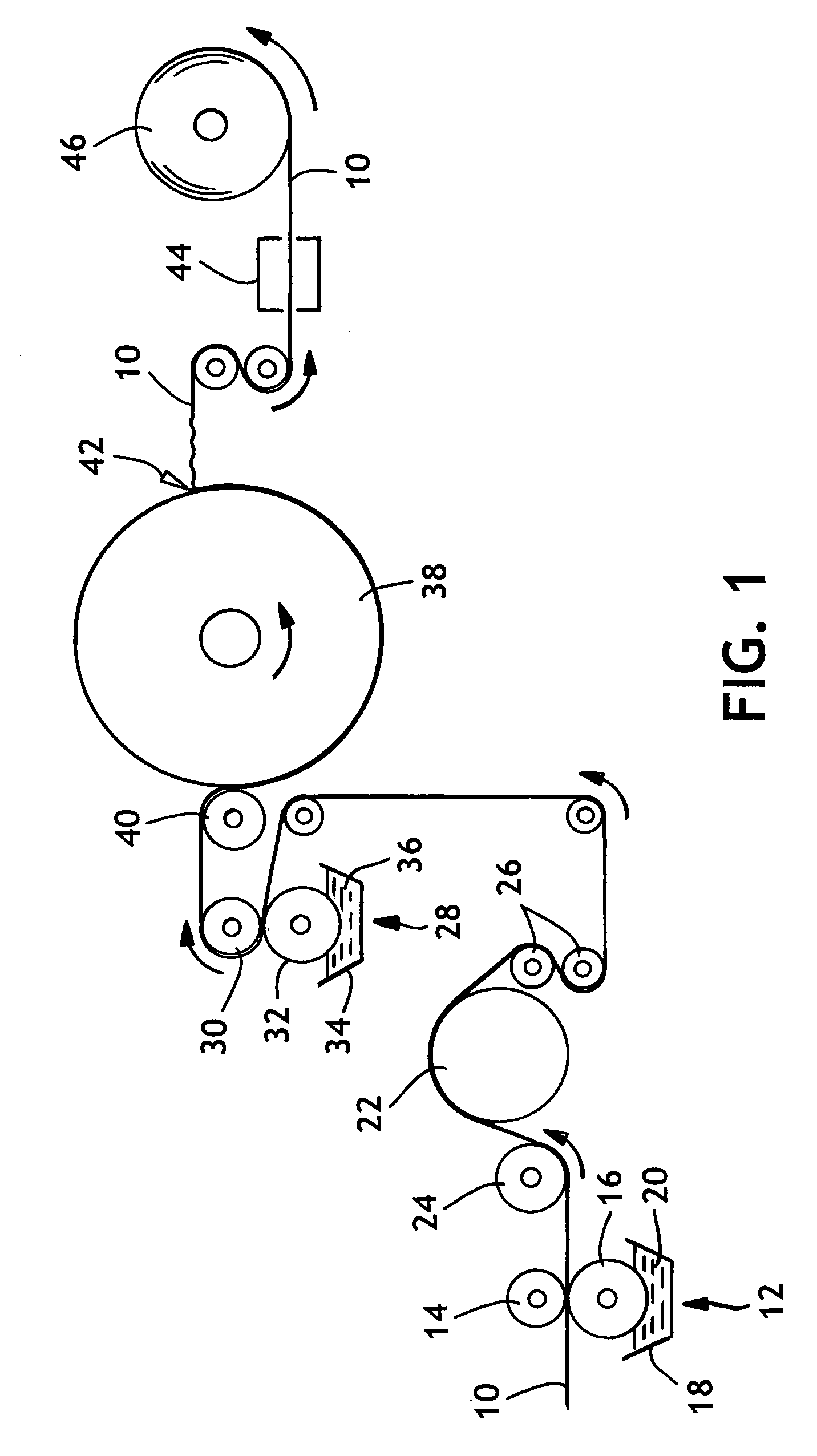Binders curable at room temperature with low blocking
a technology of curable binding and room temperature, applied in the direction of non-fibrous pulp addition, papermaking, reinforcing agent addition, etc., can solve the problems of difficult application of the binding agent, and achieve the effect of avoiding objectionable odor, and reducing the risk of odor
- Summary
- Abstract
- Description
- Claims
- Application Information
AI Technical Summary
Benefits of technology
Problems solved by technology
Method used
Image
Examples
example 1
Epoxy-Functional Reactant Control
[0050]In general, a single-ply uncreped through-air-dried (UCTAD) sheet was produced generally as described in U.S. Pat. No. 5,593,545 issued Jan. 14, 1997 to Rugowski et al., herein incorporated by reference. After manufacture on the tissue machine, the UCTAD basesheet was printed on each side with a latex-based binder. The binder-treated sheet was adhered to the surface of a Yankee dryer to re-dry the sheet and thereafter the sheet was creped and wound onto a roll without any additional thermal curing. The resulting sheet was tested for physical properties after natural aging at room temperature (about 23° C.) and humidity (about 50% relative humidity).
[0051]More specifically, the basesheet was made from a stratified fiber furnish containing a center layer of fibers positioned between two outer layers of fibers. Both outer layers of the UCTAD basesheet contained 100% northern softwood kraft pulp and about 3.5 kilograms (kg) / metric ton (Mton) of dry...
example 2
Invention
[0064]A single-ply bonded sheet was produced as described in Example 1, but using a different binder recipe. For this example, an azetidinium-functional reactant, Kymene® 557LX (Hercules Inc., Wilmington, Del.) was used. The ingredients of the “latex”, “reactant” and “thickener” are listed below.
[0065]
Latex1. Airflex ® 426 (62.7% solids)8,555g2. Defoamer (Nalco 7565)54g3. Water1,530g4. LiCl solution tracer (10% solids)65gReactant1. Kymene ® 557LX (12.5% solids)1,356g2. Water1,875gThickener1. Natrosol 250MR, Hercules (2% solids)700g
[0066]The reactant ingredients (Kymene and water) were added directly to the Latex mixture under agitation. After all ingredients had been added, the print fluid was allowed to mix for approximately 5-30 minutes prior to use in the gravure printing operation. For this bonding formulation, the weight percent ratio of azetidinium-functional polymer based on carboxylic acid-functional polymer was 3.2%.
[0067]The viscosity of the print fluid was 125 cp...
example 3
Invention
[0069]A single-ply bonded sheet was produced as described in Example 2, but using a binder recipe which was designed to reduce blocking in the finished roll. The ingredients of the “latex”, “reactant”, “anti-blocking additive” and “thickener” are listed below.
[0070]
Latex1. Airflex ® 426 (62.7% solids)6,920g2. Defoamer (Nalco 7565)40g3. Water5,485g4. LiCl solution tracer (10% solids)40gReactant1. Kymene ® 557LX (12.5% solids)2,180g
[0071]The reactant was added directly to the latex mixture under agitation. After all ingredients had been added, the print fluid was allowed to mix for approximately 5-30 minutes.
[0072]The anti-blocking additive was added next, followed by the thickener to achieve desired viscosity.
[0073]
Anti-Blocking Additive1. Glyoxal (40%) 548 gThickener1. Natrosol 250MR, Hercules (2% solids)1,010 g
[0074]After all ingredients had been added, the print fluid was allowed to mix for approximately 5-30 minutes prior to use in the gravure printing operation. For th...
PUM
| Property | Measurement | Unit |
|---|---|---|
| weight percent | aaaaa | aaaaa |
| weight percent | aaaaa | aaaaa |
| temperatures | aaaaa | aaaaa |
Abstract
Description
Claims
Application Information
 Login to View More
Login to View More - R&D
- Intellectual Property
- Life Sciences
- Materials
- Tech Scout
- Unparalleled Data Quality
- Higher Quality Content
- 60% Fewer Hallucinations
Browse by: Latest US Patents, China's latest patents, Technical Efficacy Thesaurus, Application Domain, Technology Topic, Popular Technical Reports.
© 2025 PatSnap. All rights reserved.Legal|Privacy policy|Modern Slavery Act Transparency Statement|Sitemap|About US| Contact US: help@patsnap.com


